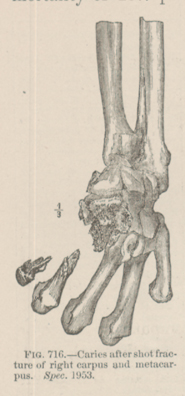Title: Johnson, D.
Source text: The Medical and Surgical History of the War of the Rebellion. (1861-65.), Part 2, Volume 2 (Washington, DC: Government Printing Office, 1876), 990.
Civil War Washington ID: med.d2e31371
TEI/XML: med.d2e31371.xml
CASE 1930.—Private D. Johnson, Co. K, 6th Pennsylvania Cavalry, aged 32 years, was wounded in a skirmish at Bristow Station, October 17, 1863. Surgeon J. B. Coover, of the regiment, reported: "Wound of right hand, partially destroying metacarpal bones." Two days after the injury the man was admitted to Lincoln Hospital, Washington. Assistant Surgeon J. C. McKee, U. S. A., reported the following history: "The ball entered at the metacarpo-phalangeal articulation of the little finger, passing through and fracturing the fourth and fifth metacarpal bones, making its exit at the dorsum. On November 1st gangrene first appeared. This was cured, and the parts remained perfectly healthy until November 15th, when gangrene reappeared in the wound. On November 28th tetanus made its appearance; patient very weak, having no appetite and being low in spirits; tetanic spasms easily excited. On December 2nd the forearm was amputated, by circular operation, at the junction of the middle and lower thirds, by Assistant Surgeon H. Allen, U. S. A. Sulphuric ether was used. During the operation the patient lost over twenty ounces of blood, producing syncope. Seven ligatures were applied. No tetanic spasms occurred after the operation. The treatment consisted of tonics, stimulants, and nutritious diet, with warm applications to the stump. The patient gradually sank, and died December 13, 1863. Some nerves must have been injured by the ball, but whether that was the cause operating to produce the fatal disease is a question. My opinion is that the primary injury done by the missile was not the cause, but the influence of the gangrene attacking the parts was the excitant of the disease." The specimen, represented in the adjacent cut (FIG. 716), was contributed by the operator. It consists of a ligamentous preparation of the carpus, metacarpus, and lowest thirds of the bones of the forearm. The dorsal surface of the os magnum and unciform are fractured, and the greater portions of the last two metacarpal bones are shattered.
